Research Article:
Faculty Satisfaction of their Course Materials Varies by Publisher
Course materials come in many different forms, from the common textbook to supplemental materials and instructor’s guides. These ratings also vary by the publisher. These all can impact the rating from faculty for its use in the classroom.Our 2021-22 Higher Education Survey asked faculty to rate their curriculum on multiple different aspects: overall, accuracy, scope of content, included instructor materials, and cost to student. As the faculty also provided the published for their courses, we are able to look at how the ratings vary by publisher.
Who publishes the primary textbook that faculty require?
The academic textbook market is composed of hundreds of publishers, many of which are specialized for a particular subject area. No one publisher commands the market in any discipline, though there are three publishers (Cengage, Pearson, and McGraw-Hill) that command a far greater market share than all other publishers. None of the other 30+ major publishers come near the market share of the “Big Three” publishers. That said, these three combined represent a minority of the market: most faculty are selecting textbooks from one of the many smaller academic publishers in our surveys.OER publishers combined make up about a tenth of the market. While relatively new, OpenStax is by far the leader among OER publishers. In fact, OpenStax market share rivals and beats the Big Three publisher for many of its disciplines. For some more information on publisher trends, see our analysis of publisher and format trends.
Why are there so many publishers of academic textbooks? There is far less consolidation than in many other industries. Is this because faculty believe that these smaller, often specialized publishers, do a better job of meeting their teaching needs? How does the growth of Open Educational Resources play into this mix?
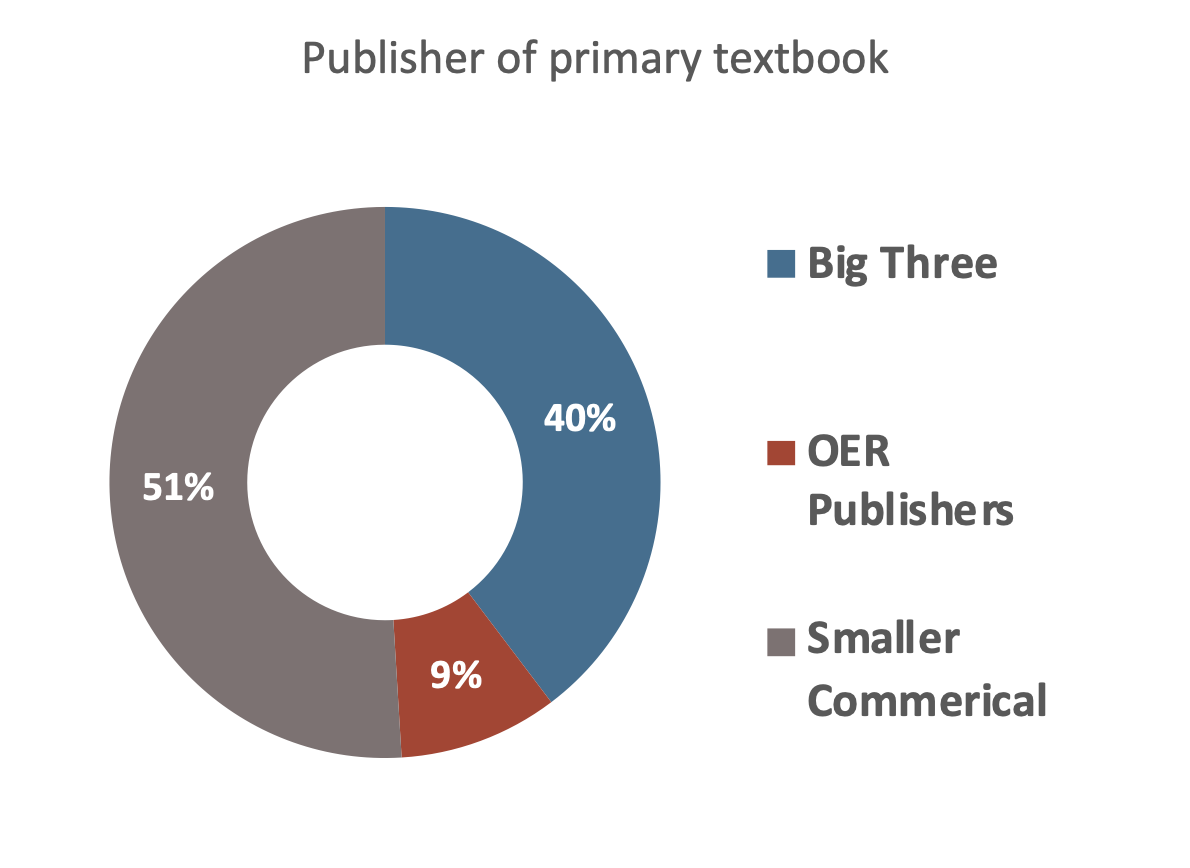
Ratings for different aspect of course materials
What aspects of courses materials are most important for faculty satisfaction? Faculty were asked to rate a number of specific aspects of their course materials on a similar 0 – 100 scale:- Scope and coverage of content
- Accuracy of content
- Included supplemental instructor material
- Cost to the student
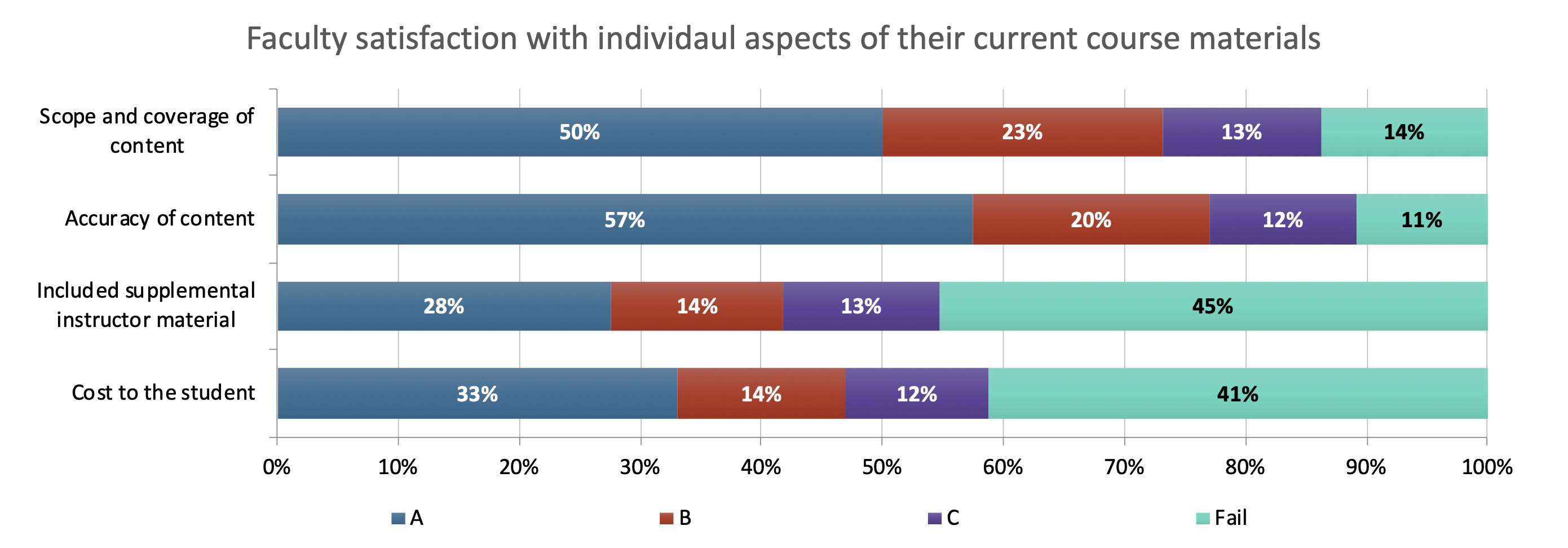
Ratings by publisher
To examine how faculty feel about different publishers, we examined the ratings of faculty who require a textbook across all the measured dimensions for three different groups: those using a textbook from one of the Big Three publishers, those using an OER textbook, and those using one of the hundreds of “other” publishers.Scope and coverage
Smaller specialized publishers are rated more highly than either the Big Three or OER materials, with OER receiving an A or B from two-thirds of the respondents, compared to three quarters of those rating the Big Three or the “other” group.It is interesting that more than 1 in ten of all faculty gave their current materials a failing grade on this aspect, with the greatest proportion (17%) occurring for OER.
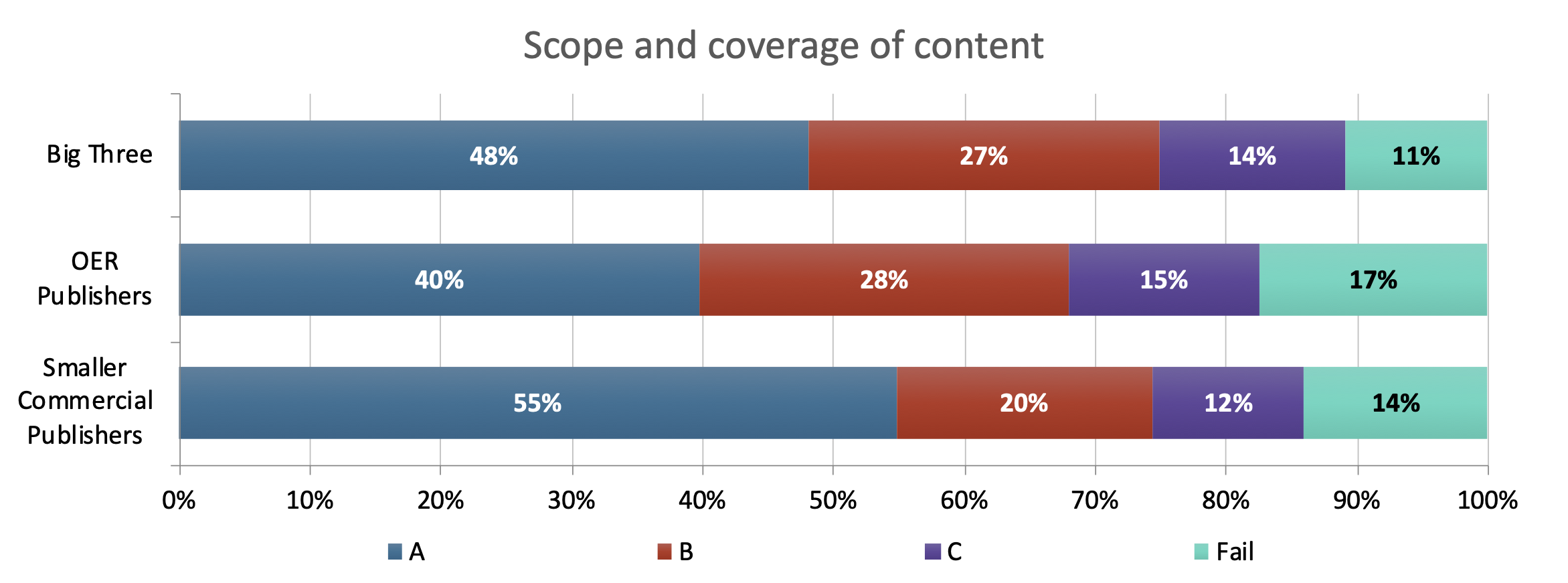
Accuracy
The smaller specialized publishers have a clear lead when judged for the accuracy of their content, with 65% of faculty giving an A rating and another 16% giving a B rating. The Big Three and OER have somewhat similar pattern, with the Big Three getting somewhat better overall ratings.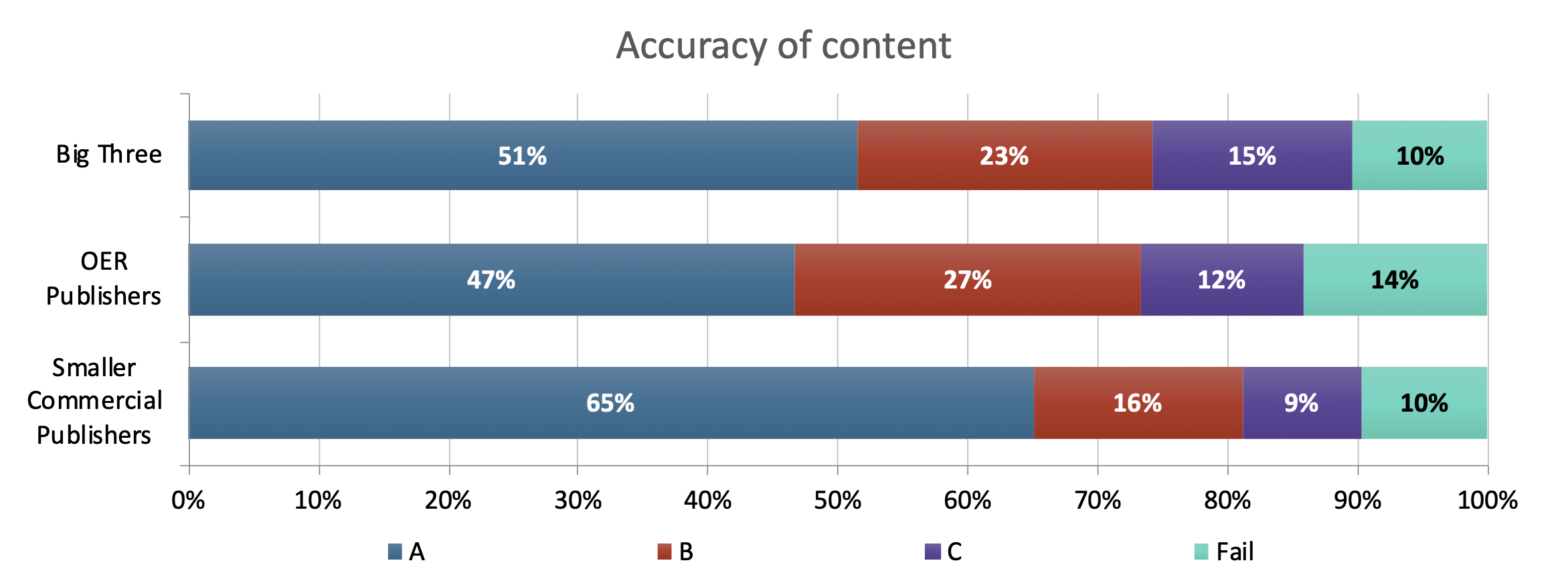
Included supplemental instructor material
It may be somewhat surprising that the smaller, specialized publishers have higher rating for supplemental materials than the Big Three publishers, as the Big Three present themselves as having all-in-one solutions. OER publishers fall behind the others in this area, with only 16% of faculty giving their supplemental materials an A rating.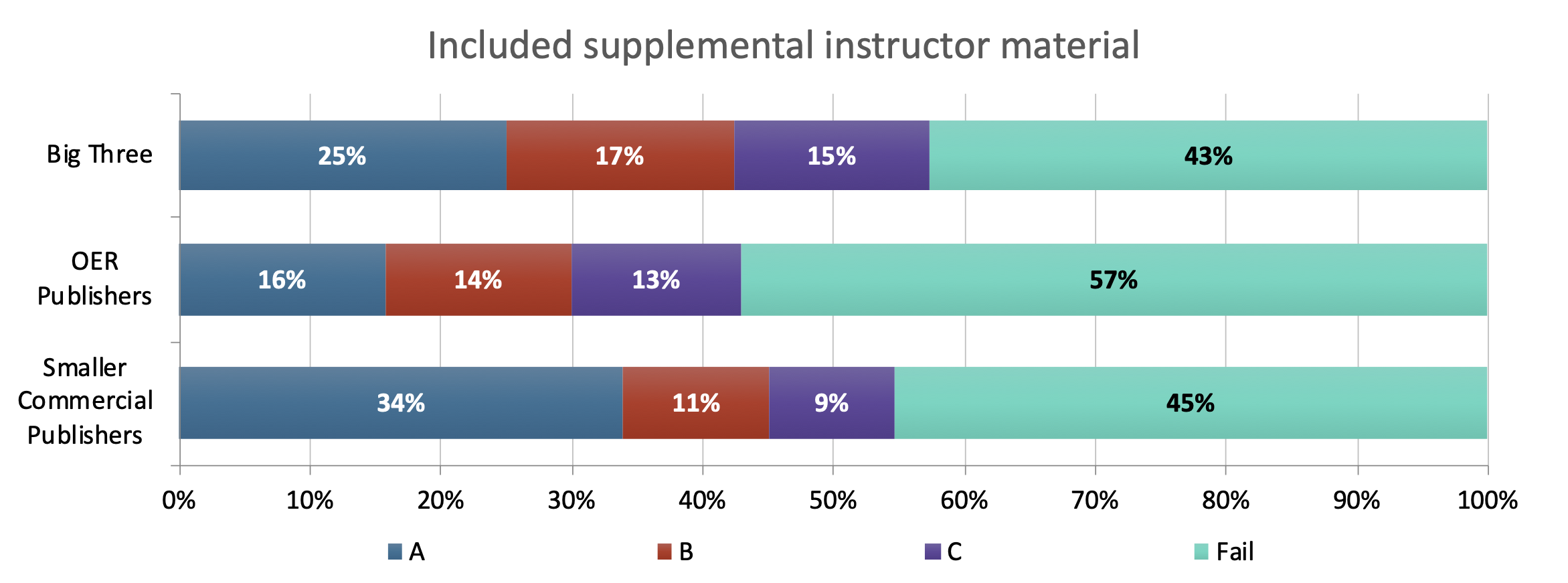
Cost to the Student
OER publishers receive almost universal high grades for cost to the student, as these materials are generally available for free or very low cost. In contrast, over half of faculty give the Big Three publishers a failing grade. The grade for smaller publishers is better than the Big Three, with roughly one third of faculty giving an A rating and another third giving a failing grade.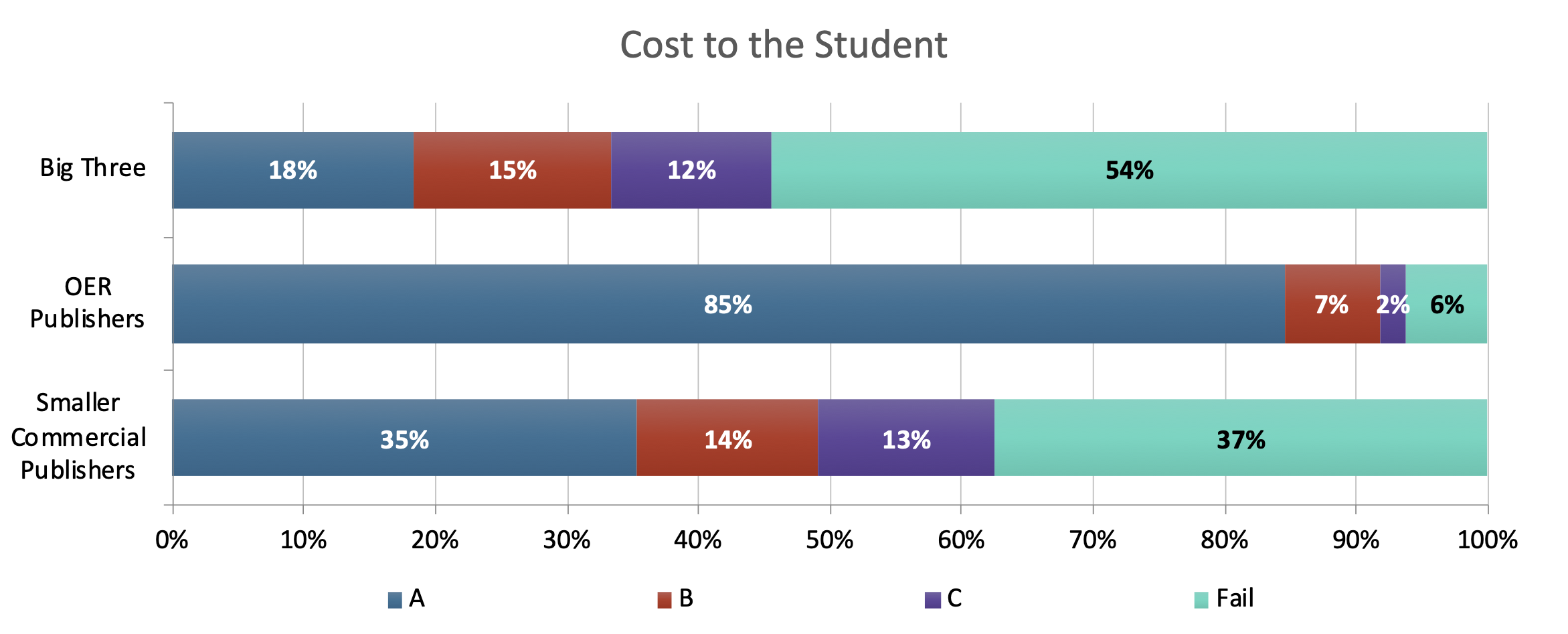
Overall rating
OER led in only one of the areas examined (cost to student), yet they emerge closely tied with the specialized publishers for the best rating from faculty for overall level of satisfaction. The smaller publishers have slightly more faculty giving them the top rating (47% compared to 45%). Finally, faculty using OER are far less likely to give their materials a failing grade: 7% for OER, 14% for smaller publishers, and 18% for the Big Three.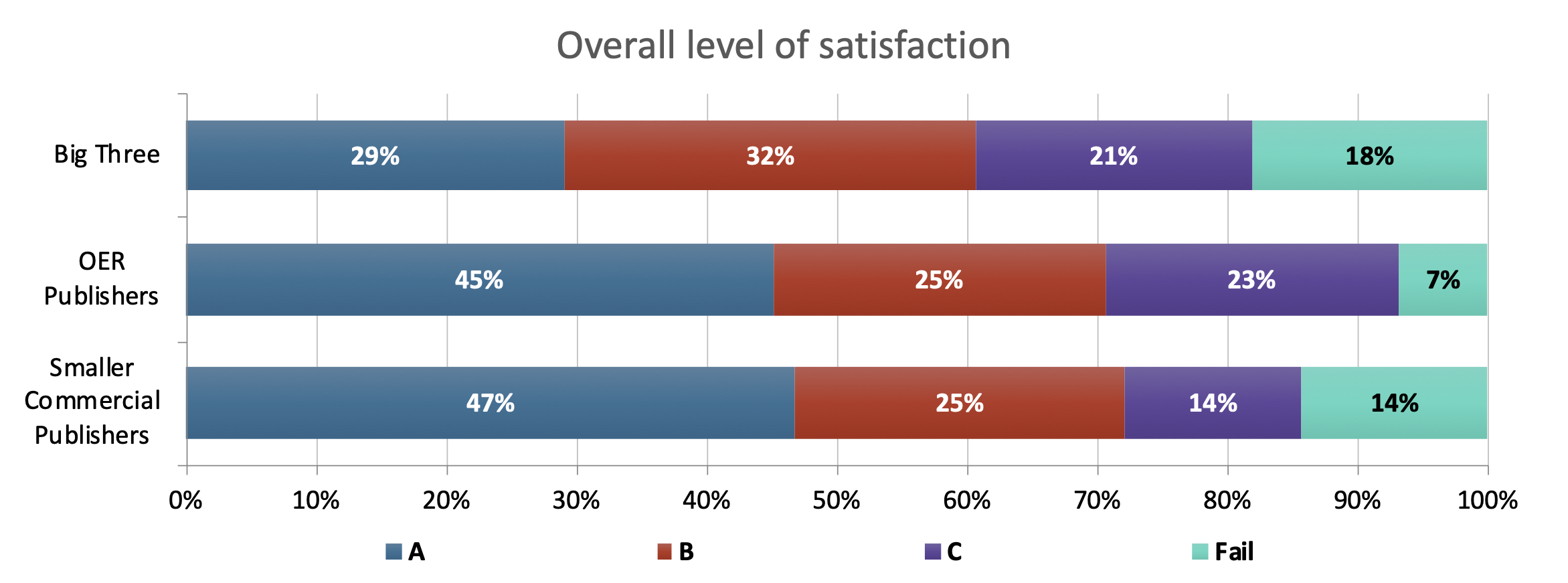
Desire to change textbook
Faculty using OER as the least likely to want to replace their current materials, followed closely by faculty using materials from one of the smaller publishers. The proportion of faculty saying they are “very unlikely” or “somewhat unlikely” to replace their textbook is very similar to the proportion of faculty giving A or B ratings. Not surprisingly, almost all faculty who give poor ratings for their textbook want to replace it.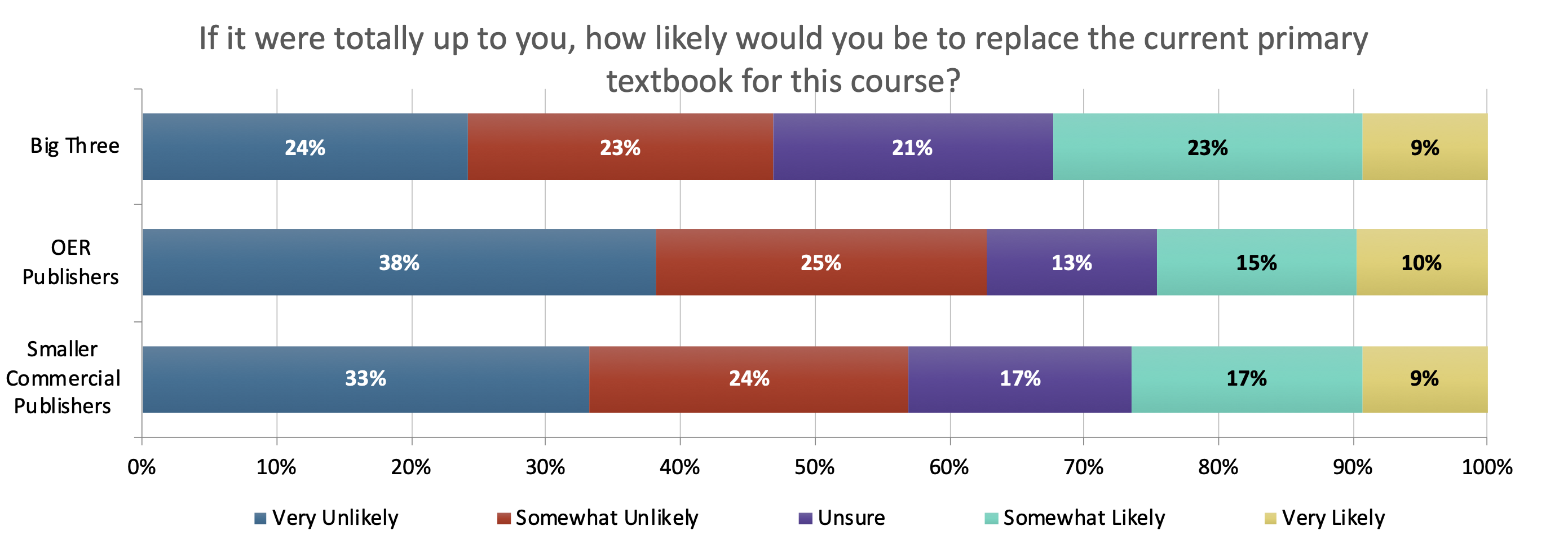
Conclusion
Faculty have a myriad of choices of sources for their course materials; the academic textbook markets is composed of hundreds of publishers, most with only very small market shares. Only three publishers (Cengage, Pearson, and McGraw-Hill) command a double-digital percentage of the market. The rest of the market is composed of many smaller publishers, often specialized with offerings for only selected disciplines. This situation has been remained relatively steady for the last decade, with one exception: Open Educational Resource publishers have grown from nearly non-existent to now beginning to rival the Big Three publishers for market share.Most faculty are satisfied with their current choice of teaching materials and would be unlikely to change even if given the chance. However, overall 29% say they would be somewhat or very likely to switch. While faculty tend to rate the coverage and accuracy of their materials highly, they are less satisfied with the supplemental materials that are provided. There is also a level of concern with access of these materials and the cost to their students.
Faculty who selected their materials from one of the smaller publishers provide consistently higher ratings that those who are using materials from the three largest publishers. They are also less likely to report that they would switch materials than faculty who selected from the larger publishers.
Faculty using Open Educational Resources are less satisfied than those using commercial options for several aspects (scope and coverage, accuracy, and supplemental materials). They have a far better level of satisfaction for the cost to their students, given the free nature of these materials. The overall level of satisfaction for OER materials is similar to, but better than, that for smaller publishers. Faculty using OER materials are the most loyal, and the least likely to report that they would consider switching.
Bay View Analytics, with support from the Hewlett Foundation, conducts annual, national surveys of faculty and administrators on topics related to curricula adoption, and tracking awareness levels of Open Educational Resources (OER) — learn more here.
Recent Publications
Digital Learning Pulse Surveys
- Infographic: 2023-2024 Digital Learning Pulse Survey
- The Digital Transformation of the Community College
- Planning for a Smaller Future: Dealing with Declining Enrollments
Course Material Affordability
- Pennsylvania Course Materials Survey 2023
- Pennsylvania Course Materials Presentation
- Course Material Webinar Slides
Open Educational Resources
- Digitally Established: Educational Resources in U.S. Higher Education, 2023
- Curricula of Many Sources: Educational Resources in U.S. K-12, 2023
- Research Brief: Digital and OER Textbook Adoption
- Research Brief: Faculty Satisfaction with Course Materials varies by Publisher
STEM
- Teaching Online: STEM Education in the Time of COVID
- What Makes a STEM Student
- Perceptions of the Future of STEM Education
Distance Education
- Digital Faculty: Faculty Social Media Use and Communications
- Infographic: Digital Faculty
- Grade Increase: Tracking Distance Education in the United States
Follow us on
Privacy
All survey respondents are provided complete anonymity. No personally identifiable information is released. Full privacy policy.